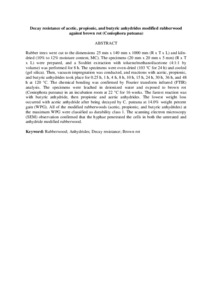Citation
Hassan, Nuraishah and Hamid, Norul Hisham and Jawaid, Mohammad and Md. Tahir, Paridah and Ujang, Salmiah
(2017)
Decay resistance of acetic, propionic, and butyric anhydrides modified rubberwood against brown rot (Coniophora puteana).
BioResources, 12 (3).
4527 - 4546.
ISSN 1930-2126
Abstract
Rubber trees were cut to the dimensions 25 mm x 140 mm x 1000 mm (R x T x L) and kiln-dried (10% to 12% moisture content, MC). The specimens (20 mm x 20 mm x 5 mm) (R x T x L) were prepared, and a Soxhlet extraction with toluene/methanol/acetone (4:1:1 by volume) was performed for 8 h. The specimens were oven-dried (103 °C for 24 h) and cooled (gel silica). Then, vacuum impregnation was conducted, and reactions with acetic, propionic, and butyric anhydrides took place for 0.25 h, 1 h, 4 h, 8 h, 10 h, 15 h, 24 h, 30 h, 36 h, and 48 h at 120 °C. The chemical bonding was confirmed by Fourier transform infrared (FTIR) analysis. The specimens were leached in deionized water and exposed to brown rot (Coniophora puteana) in an incubation room at 22 °C for 16 weeks. The fastest reaction was with butyric anhydride, then propionic and acetic anhydrides. The lowest weight loss occurred with acetic anhydride after being decayed by C. puteana at 14.0% weight percent gain (WPG). All of the modified rubberwoods (acetic, propionic, and butyric anhydrides) at the maximum WPG were classified as durability class 1. The scanning electron microscopy (SEM) observation confirmed that the hyphae penetrated the cells in both the untreated and anhydride modified rubberwood.
Download File
![[img]](http://psasir.upm.edu.my/61286/1.hassmallThumbnailVersion/Decay%20resistance%20of%20acetic%2C%20propionic%2C%20and%20butyric%20anhydrides%20modified%20rubberwood%20against%20brown%20rot%20%28Coniophora%20puteana%29.pdf)  Preview |
|
Text (Abstract)
Decay resistance of acetic, propionic, and butyric anhydrides modified rubberwood against brown rot (Coniophora puteana).pdf
Download (5kB)
| Preview
|
|
Additional Metadata
Actions (login required)
 |
View Item |

